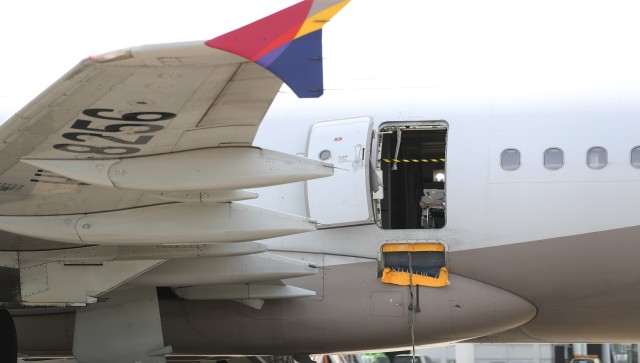You might occasionally find yourself on a plane sitting close to an emergency exit door. The exit door on a plane is asked to open in case of an emergency. However, recently, a few extremely obedient flyers have been doing the act on their own. The most recent incident included a passenger during a domestic flight in South Korea opening the emergency exit door, forcing air to gust inside the cabin before the aircraft safely landed. You’re probably now wondering what happens if an emergency exit door is opened on a plane. Let’s take a look. Asiana Airlines incident A passenger in his 30s opened the emergency exit door on the Asiana Airlines Airbus A321 as it was landing in South Korea. On Friday, the passenger seated close to the emergency door pushed a lever and released a cover just as the commercial aircraft was ready to touch down. The aircraft was over 200 metres (656 feet) above the ground. On Friday, at about 11:45 local time, Airbus A321-200 flight OZ8124 took off from Jeju Island, according to BBC.
Passengers’ hair was seen being blown about by rushing air in video footage that was allegedly captured on board and shared on social media. Nine people were sent to the hospital after the landing due to breathing problems brought on by the abrupt opening, according to Asiana, who also noted that there were no serious injuries or damage. Witnesses told local media that the plane was close to land when the flight attendants could not stop him. The aeroplane, which landed on Friday at Daegu International Airport safely but with its door still open, carried a total of 194 passengers. The man has been arrested. According to the Yonhap news agency, the 30-year-old man claimed to be feeling suffocated and that he wanted to leave right now. According to the complaint, the man allegedly told police that he was stressed out as a result of losing his work. [caption id=“attachment_12654722” align=“alignnone” width=“640”] Rescue workers move a passenger on a stretcher to an ambulance at Daegu International Airport in Daegu, South Korea. AP[/caption] It’s physically impossible to open an airplane door mid-flight There are two reasons why you cannot open the doors. The doors are mechanically locked, as you may anticipate, is the first. Pilot input regulates these locks. Mid-flight, however, is a different story as air pressure is the key factor. According to Boyle’s Law, the pressure on oxygen molecules decreases as we ascend higher in the atmosphere. It becomes more difficult to breathe since less pressure is available to allow these molecules to flow into our circulatory systems. According to Wired magazine, you’ll pass out in roughly 30 minutes once you rise above 18,000 feet because you stop taking in enough oxygen to nourish the brain. Air must be pumped into the aircraft to maintain a survivable internal pressure since aeroplanes fly between 30,000 and 43,000 feet – At this height, you’ll pass out in less than a minute and become delirious within seconds, which is why air masks fall during depressurization events and why you should take care of yourself before a newborn. In reality, while flying, we are mildly hypoxic at all times. But how does any of this relate to the plane’s doors? Simply put, the pressure within the cabin shuts them. Steve Wright, an associate professor of aerospace engineering at the University of the West of England, compares the door to a huge bath plug. By utilising the plug-hole effect, practically all aircraft exits open inward. Wright explains that if you look at the door as you exit the aircraft, you’ll see that it has an intriguing tapering design. And the reason for that is that the door is actually plugged in; as a result, the cabin crew must perform a unique type of Jimmy, or sideways shuffle, when opening it, according to the magazine. In the Asiana Airlines case, a representative of the South Korean transport ministry stated yesterday that due to identical pressures inside and outside the cabin, emergency exits might be opened at or near ground level. For those with a gloomy outlook, Wright claims that the windows are typically the weak point of the aircraft, and it’s a fact that if a door were to blow open, people would be drawn in that direction. According to Michele Meo, a professor of materials at the University of Bath, seat belt use is always advised. “In case of a decompression or doors failure, the passengers will be sucked out because of the difference in pressure pushing the passengers outside,” he explains, adding, “A notable depressurisation-related tragedy occurred with Aloha Airlines in the 1980s, but in that instance, there were already cracks inside the aircraft. From the interior, the pressure caused the break to widen and eventually tear apart the fuselage.” When opened, it is fine or imprisonment The door opens, and the alert goes to the captain. The staff then steps in and investigates why the door was opened. It can cause the takeoff to be delayed. Following the inspection, the door’s damage is evaluated, according to Business Standard. The team reports a case to the police department at the airport. Before the jet can take off again, a tonne of documentation is necessary, including giving the aviation statutory body an explanation, according to experts. Additionally, the airline may add the person to a “no-fly” list or even imprison them. This, however, will rely on the police station complaint. With inputs from agencies Read all the
Latest News
,
Trending News
,
Cricket News
,
Bollywood News
,
India News
and
Entertainment News
here. Follow us on
Facebook
,
Twitter
and
Instagram
.
Rescue workers move a passenger on a stretcher to an ambulance at Daegu International Airport in Daegu, South Korea. AP[/caption] It’s physically impossible to open an airplane door mid-flight There are two reasons why you cannot open the doors. The doors are mechanically locked, as you may anticipate, is the first. Pilot input regulates these locks. Mid-flight, however, is a different story as air pressure is the key factor. According to Boyle’s Law, the pressure on oxygen molecules decreases as we ascend higher in the atmosphere. It becomes more difficult to breathe since less pressure is available to allow these molecules to flow into our circulatory systems. According to Wired magazine, you’ll pass out in roughly 30 minutes once you rise above 18,000 feet because you stop taking in enough oxygen to nourish the brain. Air must be pumped into the aircraft to maintain a survivable internal pressure since aeroplanes fly between 30,000 and 43,000 feet – At this height, you’ll pass out in less than a minute and become delirious within seconds, which is why air masks fall during depressurization events and why you should take care of yourself before a newborn. In reality, while flying, we are mildly hypoxic at all times. But how does any of this relate to the plane’s doors? Simply put, the pressure within the cabin shuts them. Steve Wright, an associate professor of aerospace engineering at the University of the West of England, compares the door to a huge bath plug. By utilising the plug-hole effect, practically all aircraft exits open inward. Wright explains that if you look at the door as you exit the aircraft, you’ll see that it has an intriguing tapering design. And the reason for that is that the door is actually plugged in; as a result, the cabin crew must perform a unique type of Jimmy, or sideways shuffle, when opening it, according to the magazine. In the Asiana Airlines case, a representative of the South Korean transport ministry stated yesterday that due to identical pressures inside and outside the cabin, emergency exits might be opened at or near ground level. For those with a gloomy outlook, Wright claims that the windows are typically the weak point of the aircraft, and it’s a fact that if a door were to blow open, people would be drawn in that direction. According to Michele Meo, a professor of materials at the University of Bath, seat belt use is always advised. “In case of a decompression or doors failure, the passengers will be sucked out because of the difference in pressure pushing the passengers outside,” he explains, adding, “A notable depressurisation-related tragedy occurred with Aloha Airlines in the 1980s, but in that instance, there were already cracks inside the aircraft. From the interior, the pressure caused the break to widen and eventually tear apart the fuselage.” When opened, it is fine or imprisonment The door opens, and the alert goes to the captain. The staff then steps in and investigates why the door was opened. It can cause the takeoff to be delayed. Following the inspection, the door’s damage is evaluated, according to Business Standard. The team reports a case to the police department at the airport. Before the jet can take off again, a tonne of documentation is necessary, including giving the aviation statutory body an explanation, according to experts. Additionally, the airline may add the person to a “no-fly” list or even imprison them. This, however, will rely on the police station complaint. With inputs from agencies Read all the
Latest News
,
Trending News
,
Cricket News
,
Bollywood News
,
India News
and
Entertainment News
here. Follow us on
Facebook
,
Twitter
and
Instagram
.
)